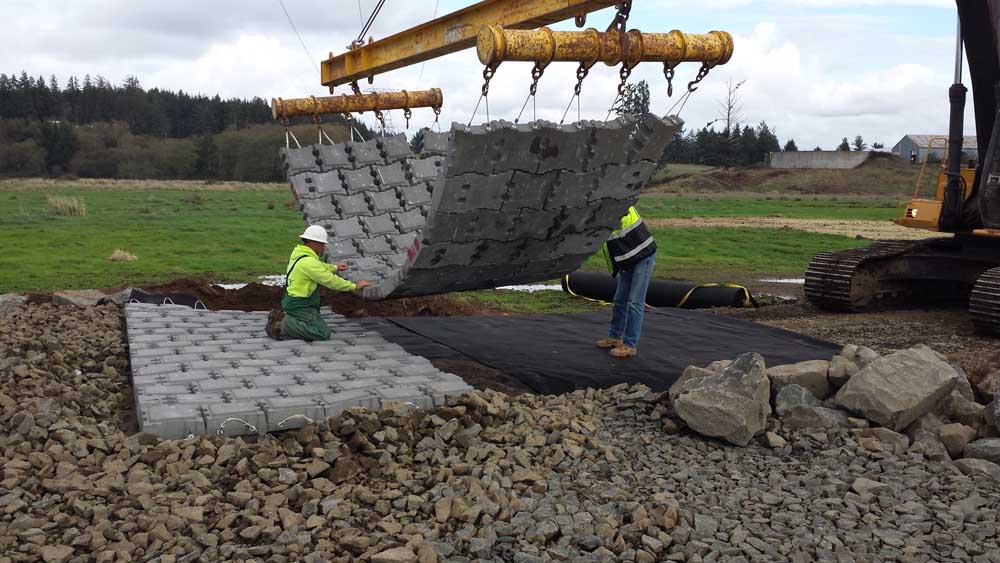From farm to wetland, a food web is born
Published 6:50 am Thursday, May 25, 2017

- Bonneville Power Administration laid a concrete road held together by cables to access transmission towers located in the Wallooskee-Youngs Confluence Restoration Project.
Along Oregon Highway 202, about a mile south of Astoria, is a talon-shaped plot of more than 200 acres bordered by the Youngs and Wallooskee rivers that is still held back by a century-old dike. A former dairy, the land is now veined with tidal inlets, the farm’s buildings only leftover concrete foundations.
This summer, the Cowlitz Indian Tribe will complete the Wallooskee-Youngs Confluence Restoration Project, which started in 2013, breaching the dike in five spots near the inlets and reconnecting 193 acres to tidal influence for estuarine salmon and wildlife habitat.
The project, estimated at approximately $10 million, is funded by Bonneville Power Administration customers. The federal agency is required by law to finance habitat restoration projects that offset the impact of the hydroelectric dams it operates along the Columbia and Snake rivers on 13 federally listed species of salmon and steelhead.
Two summers ago, Big River Construction dug out five main tidal channels throughout the property, starting at the dike and heading inland. Crews have been building concrete walls along Highway 202 to protect portions of the roadway near the restoration site from incoming tides and wave action.
Sometime between June and September, the dike will be lowered to the mean high-water level, and the dike breached near the base of each tidal channel.
“Pulling the levee down kind of helps the site deform on its own, rather than hold it to some pattern that may or may not be natural,” said Rudy Salakory, an aquatic restoration manager with the Cowlitz Tribe overseeing the project.
Salakory said the idea is that when those five tidal channels are connected to the Youngs and Wallooskee rivers, the site will start flooding twice a day, and the native plant seeds that are still present in the soil will slowly replace the pasture grass as the site becomes a wetland. The newly created wetlands will provide valuable off-channel areas for fish transitioning from fresh to saltwater, and by extension habitat for mammals, raptors, waterfowl, shorebirds and amphibians.
“We’re rebuilding that grocery store, that food web, for everyone,” Salakory said.
The site was originally diked off from the Youngs and Wallooskee rivers in the early 1900s and made into a Lee Dairy Farm in the 1970s. Salakory said maintenance of the dike surrounding the dairy was getting more difficult for the previous property owner ,Richard Lee, who in 2012 sold the land to Virginia-based environmental resources company Astoria Wetlands LLC.
The Cowlitz Indian Tribe, which has performed more than 30 restoration projects throughout the region, partnered with Astoria Wetlands and sought funding from BPA, which has financed about 45 wetland restoration sites throughout the Columbia River estuary over the past decade.
David Wilson, a spokesman for BPA, said the project is one of the largest the agency has ever funded. “Bonneville ratepayers pay for this stuff, and we want to make sure they understand that their money is going to good use,” he said.
Running through the middle of the property is BPA’s Allston-Clatsop 230-kilovolt transmission line, which goes from Longview, Washington, to provide power to much of the North Coast. To ensure the towers on raised access pads within the wetlands can still be serviced, BPA engineered a low-water access road made from concrete blocks held together by cables. The roadway is built 12 to 18 inches above the flood plain and designed to withstand daily inundation.
Once the project is completed sometime this summer, the Cowlitz Tribe will take possession of and manage the property in perpetuity for conservation. Salakory said the next step is a long-term management plan incorporating public access, such as hunting, a concern raised by residents commenting during the project’s planning stage.
“We need to balance that with good stewardship of the land,” Salakory said, adding he’ll start working on the management plan once the project is complete.
The site includes 17 acres of upland conservation area outside of the flood plain, which Salakory said could be used for a youth camp or space for powwows. The site could also grow to include native plant species used by tribes, he said, and even a potential launching spot for the annual canoe journey by Pacific Northwest tribes.
The Cowlitz Tribe’s goal in the project is to improve the resources such as fish and plants that are important to the culture of indigenous groups. “The work we do is important to all the tribes.”




